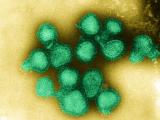Parotitis, the swelling of salivary glands most commonly associated with mumps, may be a complication of influenza infection, according to two new articles published in Clinical Infectious Diseases.
Both studies look at recent non-mumps related cases of parotitis following influenza and other viral infections, suggesting that, after ruling out mumps, clinicians should consider influenza when examining a patient who has parotitis. Interestingly, the researchers found that H3N2, the influenza A strain behind this year's severe flu season, may be more likely to cause parotitis.
In the first study, researchers from the US Centers for Disease Control and Prevention (CDC) looked at the etiology of non-mumps parotitis during the 2014-15 US influenza season in 320 American cases. The cases occurred in 27 states, mostly in men (65%). Almost two thirds of patients (64%) were under 20 year of age.
The subjects completed a questionnaire on their illness, and the CDC tested patient samples for mumps, influenza, human parainfluenza viruses 1 through 4, adenoviruses, cytomegalovirus, Epstein-Barr virus (EBV), herpes simplex viruses 1 and 2, and human herpes viruses (HHVs) 6A and 6B.
The CDC detected viruses in 210 (71%) of 294 patients who provided adequate samples for testing. The most common virus was H3N2 influenza, found in 156 patients. Other viruses detected included 42 cases of HHV6B and 32 of EBV.
Male patients more likely to be affected
In a second study, the same group of CDC researchers conducted interviews with 50 parotitis patients with lab-confirmed influenza from February to April of 2015. They compared results with responses from 124 ill influenza-confirmed controls who did not have parotitis.
"Patients described painful facial swelling, consistent with acute parotitis, which developed shortly after the onset of systemic or respiratory symptoms," the authors write. "Swelling lasted a median of 4 days before resolving. Seven cases were hospitalized during their illness, including 2 patients who were admitted to the intensive care unit."
Males were more likely to suffer from pariotitis than females, for no known reason, the authors said. Seventy-six percent of patients were male, compared with 51% of controls.
For most patients, parotitis symptoms struck about 4 days after flu symptoms, including chills, cough, muscle aches, sore throat, and fever.
The authors of the study said that, prior to the 2014-15 flu season, only 18 cumulative cases of influenza-associated parotitis were reported since 1975.
"Our findings suggest that including influenza in the differential diagnoses among patients who present with acute parotitis may be prudent during influenza season, particularly during seasons dominated by influenza A(H3N2) virus infection and when respiratory symptoms precede parotitis," the authors concluded.
Does flu cause parotitis?
In an accompanying commentary, Andrew Pavia, MD, of the Division of Pediatric Infectious Diseases at the University of Utah in Salt Lake City, notes that, although the presence of influenza virus detected in 53% of patients adds strength to the parotitis-flu association, it does not prove it.
"In the absence of experimental data or the demonstration that influenza virus replicates in salivary glands, it will be hard to prove to a high degree of scientific certainty that influenza causes parotitis, he wrote.
Pavia concludes by saying the two studies "strongly suggest that parotitis can be added to the long list of syndromes caused by influenza."
See also:
Mar 30 Clin Infect Dis "Non-mumps Viral Parotitis During the 2014-2015 Influenza Season in the United States" study
Mar 30 Clin Infect Dis "Influenza-Associated Parotitis During the 2014-2015 Influenza Season in the United States" study
May 30 Clin Infect Dis commentary





















